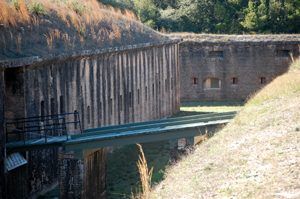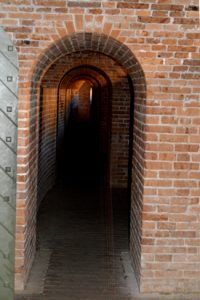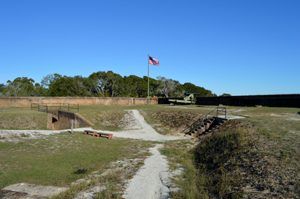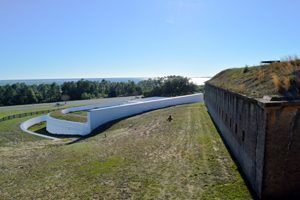
Fort Barrancas, Florida, by Dave Alexander
Fort Barrancas, also called Fort San Carlos de Barrancas, is a part of the Pensacola, Florida, forts area of the Gulf Islands National Seashore. Located onboard the Pensacola Naval Air Station, the fort is protected by the National Park Service.
Fort Barrancas was built on the site of numerous previous forts, including Fort San Carlos de Austria, which was constructed by the Spanish in 1698. It was besieged in 1707 by Indians under the general leadership of some English traders but was not taken. In 1719 French forces captured Pensacola and destroyed the Spanish fort.
Following Britain’s defeat of the French in the Seven Years’ War in 1763, it exchanged some territory with Spain and took over the West. The British used this site as a harbor fortification, building the Royal Navy Redoubt in 1763. More than a decade later, as enemies of the British, the Spanish joined the war against them in 1779 during the American Revolution, though they never officially became American allies. They took Pensacola in 1781 and built new fortifications on the bluffs — Bateria de San Antonio and the Castillo de San Carlos.
During the War of 1812 between the United States and England, the fort was the scene of the American victory at the Battle of Pensacola in 1814. It was fought between American forces commanded by General Andrew Jackson and some Indian allies and the allied forces of the British, Spanish, and Creek Indians.
American units raided West Florida. In 1818, the Spanish garrison of the fort exchanged cannon fire with an American battery for a few days. The U.S. force was led by General Jackson. Eventually, the Spanish surrendered the fort, leaving Pensacola in American hands.
When the United States purchased Florida from Spain in 1821, the U.S. Navy selected Pensacola Bay as the site for a United States Navy Yard. U.S. Army engineers made plans to construct new harbor defenses on the bluffs. In addition, the U.S. developed plans to construct additional harbor fortifications to protect this deepwater bay. Fort Pickens was completed on Santa Rosa Island in 1834, and Fort McRee was completed in 1839 to defend the pass to Pensacola Bay. The Spanish water battery was improved, and Fort Barrancas was built over the ruins of Fort San Carlos between 1839 and 1844. It was strengthened to defend against both ships entering the harbor and attacking across land. The Advanced Redoubt was built north of the fort, and a trench line connected them. This system protected the Navy Yard to the east from infantry attacks.
On January 10, 1861, Florida succeeded from the Union. A force of 50 United States Regulars under Lieutenant Adam Slemmer, plus 30 sailors, occupied Fort Pickens on Santa Rosa Island. Rebel troops controlled all other installations in the area, but without Fort Pickens, they could not effectively use the harbor. To forestall bloodshed, the North and South negotiated a truce. The Civil War began in mid-April 1861. Fort Pickens was reinforced while the Confederate Army of Pensacola (some 8,000 strong) held a position from Fort McRee to the Navy Yard. In September, Federals raided the Navy Yard, destroying the Confederate Schooner Judah. In October, Confederates raided the island, destroying the New York 6th volunteer Infantry camp. On November 22nd and 23rd, in an artillery duel, 5,000 shots and shells were exchanged. Neither side suffered extensively. A second bombardment on January 1, 1862, was ineffective in driving the antagonists from their defenses. In May 1862, the Confederates pulled out of Pensacola, and Union forces reoccupied all the harbor installations. Fort Barrancas saw no further combat.
After the Civil War, stronger, rifled cannon and ironclad ships made masonry forts like Fort Barrancas outmoded. The Army used the fort as a signal station, small arms range, and storage area until 1946. Newer weapon technology developed during World War II made coastal defense completely obsolete, and Fort Barrancas was deactivated on April 15, 1947.
The U.S. Navy then incorporated the site into Naval Air Station Pensacola. At the same time, local leaders, Congress, and the National Park Service were working to designate the harbor defenses of Pensacola as a historic national monument. In 1971, Congress authorized the establishment of the Gulf Islands National Seashore, which included Fort Barrancas. After a $1.2 million restoration, Fort Barrancas was opened to the public in 1980.
Fort Barrancas and the nearby Advance Redoubt are located at Naval Air Station in Pensacola, but they are both managed as historic properties by the National Park Service. Access to Naval Air Station Pensacola by non-Department of Defense-affiliated personnel may be subject to homeland security and military force protection concerns. Visitors can tour the restored fort and battery, learn about the fort’s history through the exhibits in the visitor center, and walk the trails to the Advance Redoubt on board Pensacola Naval Air Station.
© Kathy Alexander/Legends of America, updated November 2022.
Also See:
Gulf Islands National Seashore
Sources:
National Park Service
Wikipedia
![]() Creative Commons Attribution-ShareAlike
Creative Commons Attribution-ShareAlike




